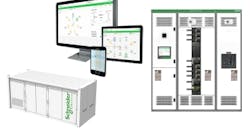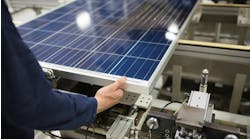The relationship between microgrids and sustainability
In May, Schneider Electric announced the launch of its EcoStruxure Microgrid Flex, a microgrid system to empower businesses to take the future of sustainability into their own hands by reducing downtime, greenhouse gas emissions, and energy waste. Schneider claimed that the solution “will bring the process of specification, design, and build down to months instead of years for microgrid system projects.”
Lofty goals. We wanted to learn more, so we connected with Bala Vinayagam, SVP of microgrids at Schneider Electric. Take a look…
Smart Industry: How are microgrids being used in the industrial space?
Bala: Microgrids are being used in the industrial space to improve reliability, resilience and sustainability. They can provide backup power during outages, reduce reliance on the grid, and enable the use of renewable-energy sources. Microgrids can provide backup power during outages, which is essential for critical infrastructure such as hospitals, data centers, and manufacturing plants. They are also instrumental in helping industrial facilities reduce their reliance on the grid, which can save them money on their energy bills. Most notably, microgrids can be used to integrate renewable-energy sources such as solar and wind power, which can help industrial facilities reduce their carbon footprint.
Schneider Electric has extensive experience in this space, including a recent project for Mtech headquarters and the first industrial microgrid with Acciona Energia. The new Mtech headquarters achieves the first industrial islandable microgrid in Spain, with solutions from Schneider Electric.
Smart Industry: How is this use changing as digital transformations mature?
Bala: Digital technologies are enabling simpler ways to design, build and operate microgrids, which is making them more attractive to industrial customers. Digital technologies are making it possible to design microgrids that are more resilient to outages, while maximizing renewables, which helps underscore microgrids as a lucrative option for industrial businesses looking to accomplish both objectives. Digital advancement in advanced sensors and controls, remote monitoring and management, and data analytics can improve overall industry resilience and efficiency of design, operation and maintenance, and microgrids can champion these features.
Smart Industry: What is the relationship between microgrids and sustainable manufacturing?
Bala: Microgrids can offer a number of benefits to manufacturing facilities, including:
- Load management and generation-forecast coordination to maximize renewable integration.
- Leveraging electrification of energy uses in the sustainable-manufacturing transformation.
- Increased reliability: microgrids can provide backup power in the event of a power outage, which can help to keep manufacturing facilities running.
- Reduced costs: Microgrids can help to reduce energy costs by enabling manufacturers to generate their own power.
- Increased sustainability: Microgrids can be powered by renewable-energy sources with seamless integration, which can help manufacturers reduce their environmental impact.
In addition to these benefits, microgrids can also offer a number of other advantages to manufacturing facilities, such as:
- Improved flexibility: microgrids can be easily scaled up or down to meet the changing needs of a manufacturing facility.
- Increased resilience: microgrids can help manufacturing facilities to withstand natural disasters and other disruptions.
Smart Industry: Who is most aggressively adopting this approach? Who can most benefit from smart uses of microgrids?
Bala: We see other industries and segments growing for various use cases, including:
- Critical infrastructure organizations: microgrids can provide backup power to critical-infrastructure organizations, such as hospitals, data centers and airports. This can help to keep these organizations running even in the event of a power outage.
- Remote communities: microgrids can provide power to remote communities that are not connected to the main power grid. This can help to improve the quality of life in these communities and to reduce their reliance on fossil fuels.
- Commercial and industrial properties: microgrids can help commercial and industrial properties reduce their energy costs and to improve their sustainability. They can also help to improve the resilience of these properties to power outages.
Smart Industry: How do microgrids quicken the processes of specification, design and build?
Bala: Microgrids are typically designed and built for unique and individualized designs. This time to engineer the system design and test/validate is time-intensive. Microgrids must be standardized, repeatable and quick to configure for each use case to grow adoption and impact for enterprises, buildings and facilities of all sizes. In an ideal microgrid, all the tools to design, build, commission, and operate it are Included in the solution that services it. And, because of standardization, they can be configured faster, using tested, validated and documented architectures, along with accompanying hardware, software and services.
Smart Industry: What does the near future look like regarding these uses of microgrids?
Bala: Many large companies now have initiatives to reduce their carbon footprint, which includes several different methods. One of the biggest and most challenging is reducing Scope 3 Emissions, the emissions that are produced indirectly (suppliers, supply chain, production, etc.). This now forces manufacturers to reduce their environmental impact if they want to grow their business. Microgrids solve this challenge for them in a few different areas. For manufacturers of organic products, microgrids ensure the reliability of the production and storage of these items. Microgrids are an integral and vital part of the new energy landscape and optimizing distributed energy resources as part of a more flexible and decarbonized grid.



